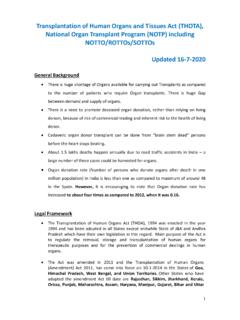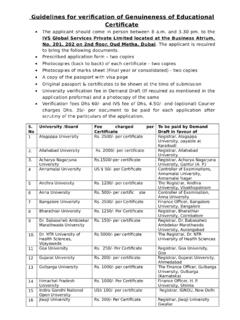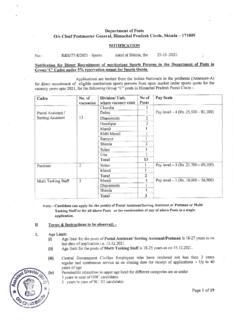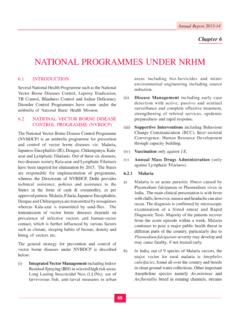Transcription of Himachal Pradesh: A Profile N
1 A brief overview of the evolution of Himachal Pradeshas a state, its geographical location and economy, canprovide the background to issues discussed in the StateDevelopment Report of Himachal pradesh . This chapterplaces the state in the national context and also dealswith the problems of its intra-regional disparities,resources and the physical, social and economicinfrastructures necessary for its all round history of human settlement in HimachalPradesh goes back to the palaeolithic period of whichstone tools and flakes have been discovered in the valleysof the Sutlej and Beas rivers and also in the foothill zoneof the Shivalik hills. Numerous tribes settled in differentparts of the region. The recorded history begins witheffect from the Maurya period, that is 4th Century ,when this part of India was an outlier of Chandragupta skingdom.
2 Throughout its history, the present territory ofHimachal pradesh remained segmented into a number ofprincipalities, usually under the hegemony of an empirecentered at Delhi. The area has also been a refuge forseveral freedom-loving population groups/castes,particularly Rajputs and Brahmins who refused to liveunder the imperial authority centered at Delhi. Theysettled in specific parts of this region, which took theform of small/tiny states under the chiefdom of Rajputprinces. The colonial empire brought them under thehegemony of the British Crown in 1859. They continuedenjoying a degree of autonomy but were essentially inthe nature of feudatory states. On the eve ofIndependence of India, half of the present territory ofHimachal pradesh was divided into 30 princely states andthe other half was a part of the Punjab province of theBritish Empire.
3 Himachal pradesh acquired its presentdisposition in phases over time after now is one of the most dynamic hill statesof India. It scores significantly high on indicators ofChapter 1 Himachal pradesh : A Profilehuman development. Its resources of forests, fruits,minerals, health resorts, and hydel power hold thepromise of great progress. Natural assets for tourism inthe state are ideal. It has its own rich culture,physiography suited to almost all types of crops andfruits, and an independent administrative identity. Itsnotable accomplishments have been in literacy,agriculture, horticulture, roads, forests, hydel powergeneration and tourism. The state is called the applebelt of India. Its vast potential for hydel powergeneration, because of its locational advantage, hasattracted the attention of the entire nation, as a majorresource awaiting full exploitation.
4 Its physicaldiversity, its climate and its peaceful environment canderive high economic value from the development of thetourist pradesh in the National ContextHimachal pradesh with an area of 55,673 sq. km. isone of the smaller states of India (Table ). It ranks17th among the States and Union Territories in terms ofarea, which is one-sixth of the largest state -Rajasthan. With a population of lakh, HimachalPradesh ranks 21st among the States and UnionTerritories. That its population is 27 times below thatof the most populous state, Uttar pradesh , is anindicator of its state accounted for per cent of the total areaof the country and per cent of the total populationin 2001. With a density of 109 persons per sq. km., itranks 28th among the states and Union Territorieswhich is much below the all-India average of 324persons per sq.
5 Urban population constitutes per cent ofthe total population of the state, the lowest among allStates and Union Territories. Almost eight out of everyDEVELOPMENT REPORTHIMACHAL PRADESHPLANNING COMMISSIONGOVERNMENT OF INDIAHHHIMACHAL pradesh DEVELOPMENT REPORT40 TABLE of Himachal pradesh on Selected Parameters in India, 1999-2001 States/Union TerritoriesArea*(in sq. km.)Population#Density#Urban Population#Literate#Per Capita Income##(persons per(in per cent)(in per cent)(Rs.) 2000-01 (P)sq. km.)at 1993-94 BaseIndia32,87,263102,70,15, Pradesh2,75,0697,57,27, Pradesh83,74310,91, Assam78,4382,66,38, ,1638,28,78, ,35,1332,07,95, *Goa3,70213,43, ,96,0245,05,96, ,2122,1,082, Pradesh55,67360,77, and Kashmir2,22,2361,00,69, ,7142,69,09, *Karnataka1,91,7915,27,33, ,8633,18,38, Pradesh3,08,0006,03,85, ,07,7139,67,52, ,172 Manipur22,42923,88, Meghalaya22,42923,06, ,0878,91, Nagaland16,57919,88, Orissa1,55,7073,67,06, ,3622,42,89, ,42,2395,64,73, ,0965,40, Tamil Nadu1,30,0586,21,10, Tripura10,49131,91, Pradesh2,38,56616,60,52, ,48484,79, *West Bengal88,7528,02,21, TerritoriesAndaman and Nicobar Islands8,2493,56, *Chandigarh1149,00, and Nagar Haveli4912,20, *Daman and Diu1121,58, *Delhi1,4831,37,82, *Lakshadweep3260, *Pondicherry4929,73, *Source:# -Census of India, 2001, Provisional Population Totals, Paper-1 of 2001, DCO, Punjab.
6 ## -Statistical Abstract of Punjab, 2002, Economic Advisor to Government of Punjab, Chandigarh.* -Ministry of Information and Broadcasting (2003): India 2002, A Reference Annual, Publication Division, Government of India, New persons in the state are literate, and it ranks 11th interms of of the StateHistorically, Himachal pradesh has not onlyexperienced different stages of social transformation,but has also seen many changes in its size andadministrative structure. Comprising 30 princely states,it came into existence as a Chief CommissionersProvince in 1948, and graduated through a number ofstages of administrative transformation to a full-fledgedstate of the Indian Union in 1971. To start with, itconsisted of four districts Chamba, Mahasu, Mandiand Sirmaur. Under the rule of the princes, this regionsuffered from the worst kind of feudal exploitation.
7 Therulers did not consider it necessary to develop theirterritories, by utilising the available wealth of naturalresources ( Singh, 1985). Since its formation41 Chapter 1 Himachal pradesh : A PROFILES ource:Census of India, 2001, Provisional Population Totals, Paper 1 of 2001, Himachal pradesh , Directorate of Census Operations, Himachal Himachal pradesh DEVELOPMENT REPORT42 Source:Census of India, 2001, Provisional Population Totals, Paper 1 of 2001, Himachal pradesh , Directorate of Census Operations, Himachal 43 Chapter 1 Himachal pradesh : A PROFILEH imachal has, however, attained a high level of changes in size and the administrative structurethat the state has gone through between 1948 and1971 have influenced the level and pace of itsdevelopment. Himachal inherited a primitive economicsystem from its feudal structure, and an inadequateinstitutional framework, which constituted a weak basefor socio-economic development.
8 Thus, at the initialstages the state was at a disadvantage in relation to therest of the country in pursuing the process ofdevelopment. In this context, the institutional task ofsetting up an integrated administration, transforming afeudal system into a modern democratic one,necessitating the abolition of all feudal practices andlaws, was certainly fairly difficult ( Sharma, 1985).The merger of the princely state of Bilaspur in 1954enlarged the geographical area of Himachal pradesh andincreased the number of its districts to five. In 1960, anew district of Kinnaur was carved out of states reorganisation of 1966 transferred parts ofPunjab (Ambala, Hoshiarpur and Gurdaspur) toHimachal pradesh , adding three more districts, namely,Kangra, Kullu, and Lahaul and Spiti. These areas wereunder the direct administration of the BritishGovernment before independence and were far behindthe other progressive regions of Punjab and failed toachieve substantial economic development, until theirintegration with Himachal pradesh ( Singh, 1985).
9 On 25 January 1971, the state was granted full-fledged statehood. Una and Hamirpur districts werecarved out of Kangra district and Mahasu district wasdivided into Shimla and Solan districts on September 1,1972. The people of the state classify themselves intotwo sub-regional identities: the old Himachal Pradeshand the new Himachal pradesh . The erstwhile princelystates constitute the old Himachal and territories thatwere earlier part of Punjab, form the new areas. Theformer is less developed than the has been no change in the number of districtssince 1972, even though there are substantial variationsin area and population of the districts. Lahaul andSpiti, with an area of 13,835 sq. km. is the largestdistrict. It contains per cent of the state s areafollowed by Chamba with per cent (Table ).
10 Hamirpur with per cent of the area of the state isat the bottom with Bilaspur ( per cent) coming , these rankings become totally different, oncethe population is taken into account. Lahaul and Spiti,which occupies the first place in terms of area, isrelegated to the last position with a population of33,224, Kinnaur with 83,950 coming next. Chamba, thesecond largest in area, occupies the fifth position interms of population. Almost half the population lives inthree districts Kangra, Mandi and Shimla and thebottom three districts of Lahaul and Spiti, Kinnaur andBilaspur, share per cent of the state s variations in the land-man ratio are reflected inthe density of population. The low density ofpopulation in the larger districts is due to the limitedarable land, unfavorable physio-geographical conditions,poor means of transport and communication, hostileclimate and the low level of economic Status of Selected Parametersin Himachal pradesh , 2001 DistrictAreaPopulationDensityUrbanLitera tes(in 000 sq.)














